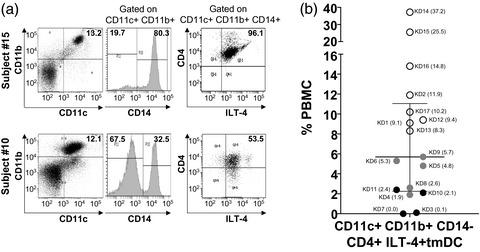当前位置:
X-MOL 学术
›
Clin. Exp. Immunol.
›
论文详情
Our official English website, www.x-mol.net, welcomes your
feedback! (Note: you will need to create a separate account there.)
Characterization of circulating immune cells in acute Kawasaki disease suggests exposure to different antigens.
Clinical & Experimental Immunology ( IF 3.4 ) Pub Date : 2020-08-18 , DOI: 10.1111/cei.13506 J C Burns 1 , L E Hsieh 1 , J Kumar 1 , N Behnamfar 1 , C Shimizu 1 , N Sivilay 1 , A H Tremoulet 1 , A Franco 1
Clinical & Experimental Immunology ( IF 3.4 ) Pub Date : 2020-08-18 , DOI: 10.1111/cei.13506 J C Burns 1 , L E Hsieh 1 , J Kumar 1 , N Behnamfar 1 , C Shimizu 1 , N Sivilay 1 , A H Tremoulet 1 , A Franco 1
Affiliation

|
Kawasaki disease (KD) is an acute pediatric vasculitis of unknown etiology that can cause coronary artery aneurysms, and is the leading cause of acquired heart disease in children. We studied aspects of the innate and adaptive immune response in 17 acute KD children prior to treatment with intravenous immunoglobulin. Distinct patterns within the innate immune response correlated with specific clinical features. Proinflammatory myeloid dendritic cells (mDC) were abundant in four of 17 (23·5%) subjects who were older and manifested severe inflammation with clinical myocarditis and elevated hepatobiliary enzyme levels. Of the nine subjects with low levels of anti‐inflammatory, tolerogenic mDC, six had enlarged cervical lymph nodes at diagnosis. In contrast, the adaptive immune repertoire varied greatly with no discernible patterns or associations with clinical features. Two subjects with aneurysms had numerous circulating CD8+ T cells. Ten subjects showed low CD4+ T cell numbers and seven subjects had CD4+ T cells in the normal range. CD4+ T cells expressed interleukin‐7 receptor (IL‐7R), suggesting repeated antigenic stimulation. Thymic‐derived regulatory T cells (nTreg) and peripherally induced regulatory T cells (iTreg) were also enumerated, with the majority having the nTreg phenotype. Natural killer (NK) and NK T cell numbers were similar across all subjects. Taken together, the results of the immune monitoring suggest that KD may have multiple triggers that stimulate different arms of the innate and adaptive compartment in KD patients. Thus, it is possible that diverse antigens may participate in the pathogenesis of KD.
中文翻译:

急性川崎病中循环免疫细胞的特征表明暴露于不同的抗原。
川崎病(KD)是一种病因不明的急性小儿血管炎,可引起冠状动脉瘤,是儿童获得性心脏病的主要原因。我们研究了 17 名急性 KD 儿童在静脉注射免疫球蛋白治疗前的先天性和适应性免疫反应。先天免疫反应中的不同模式与特定的临床特征相关。17 名受试者中有 4 名 (23·5%) 年龄较大且表现出严重的炎症,伴有临床心肌炎和肝胆酶水平升高,其中有四名有大量促炎性髓样树突状细胞 (mDC)。在 9 名抗炎、耐受性 mDC 水平低的受试者中,有 6 名在诊断时颈部淋巴结肿大。相比之下,适应性免疫库变化很大,没有明显的模式或与临床特征的关联。两名患有动脉瘤的受试者有大量循环 CD8+ T 细胞。10 名受试者的 CD4 + T 细胞数量较低,7 名受试者的 CD4 + T 细胞数量在正常范围内。CD4 + T 细胞表达白细胞介素-7 受体 (IL-7R),表明反复的抗原刺激。胸腺来源的调节性 T 细胞 (nT reg ) 和外周诱导的调节性 T 细胞 (iT reg ) 也被列举,其中大多数具有 nT reg表型。所有受试者的自然杀伤 (NK) 和 NK T 细胞数量相似。总之,免疫监测结果表明,KD 可能有多种触发因素,可刺激 KD 患者先天性和适应性隔室的不同臂。因此,多种抗原可能参与 KD 的发病机制。
更新日期:2020-08-18
中文翻译:

急性川崎病中循环免疫细胞的特征表明暴露于不同的抗原。
川崎病(KD)是一种病因不明的急性小儿血管炎,可引起冠状动脉瘤,是儿童获得性心脏病的主要原因。我们研究了 17 名急性 KD 儿童在静脉注射免疫球蛋白治疗前的先天性和适应性免疫反应。先天免疫反应中的不同模式与特定的临床特征相关。17 名受试者中有 4 名 (23·5%) 年龄较大且表现出严重的炎症,伴有临床心肌炎和肝胆酶水平升高,其中有四名有大量促炎性髓样树突状细胞 (mDC)。在 9 名抗炎、耐受性 mDC 水平低的受试者中,有 6 名在诊断时颈部淋巴结肿大。相比之下,适应性免疫库变化很大,没有明显的模式或与临床特征的关联。两名患有动脉瘤的受试者有大量循环 CD8+ T 细胞。10 名受试者的 CD4 + T 细胞数量较低,7 名受试者的 CD4 + T 细胞数量在正常范围内。CD4 + T 细胞表达白细胞介素-7 受体 (IL-7R),表明反复的抗原刺激。胸腺来源的调节性 T 细胞 (nT reg ) 和外周诱导的调节性 T 细胞 (iT reg ) 也被列举,其中大多数具有 nT reg表型。所有受试者的自然杀伤 (NK) 和 NK T 细胞数量相似。总之,免疫监测结果表明,KD 可能有多种触发因素,可刺激 KD 患者先天性和适应性隔室的不同臂。因此,多种抗原可能参与 KD 的发病机制。











































 京公网安备 11010802027423号
京公网安备 11010802027423号